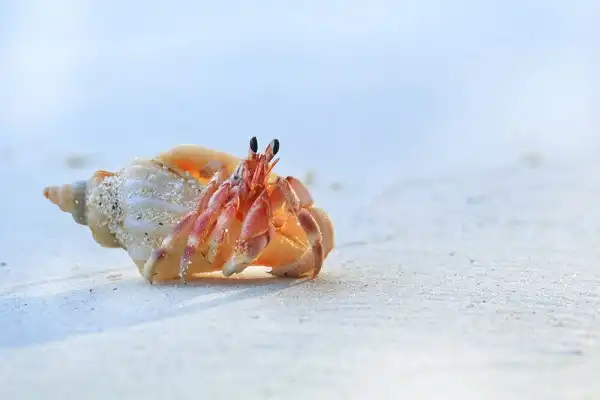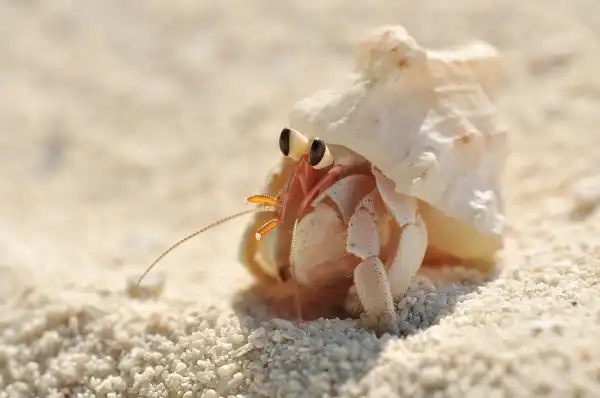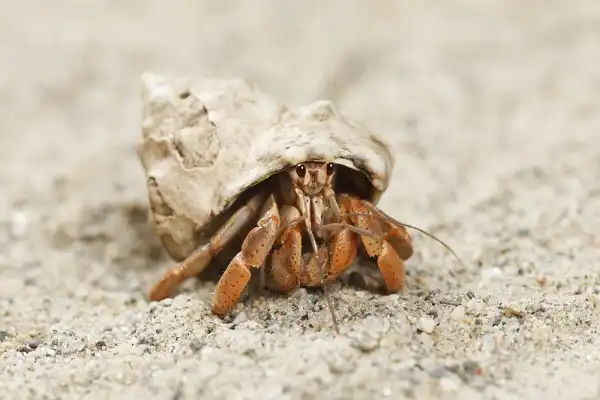Have you ever heard of the tiny creatures called hermit crabs? Most people think of these little critters as nothing more than something to buy at a pet store, but they can actually make great and interesting pets. Hermit crabs have been keeping aquariums occupied for years, and their unique personalities can make them an especially fun companion in a home. In this blog post, we’ll take a look at why exactly these curious crustaceans are such delightful pets, exploring the different aspects that make hermit crab care both rewarding and enjoyable. Read on to learn about the advantages that come with keeping your own hermit crab!

Hermit Crab Description
Hermit crabs are small, soft-bodied crustaceans with a hard exoskeleton that is made up of two sections. The first section is the cephalothorax, which houses the crab’s eyes, mouthparts, and claws. The second section is the abdomen, which is flexible and contains most of the internal organs. Hermit crabs come in many sizes and colors, ranging from just a few millimeters to more than 6 inches long. Common colors for hermit crabs include brown, green, blue, and white; they can also be speckled or striped with multiple colors. Hermit crabs have two sets of antennae on their heads to sense their environment; one set is used to detect food and the other to feel its way around obstacles or in dark crevices. They also have four pairs of walking legs and two sets of claws that they use to move around and climb walls or trees. These incredibly strong pincers also help them find food by picking it up or breaking it into smaller pieces that can be eaten.
Hermit Crab Habitat
Hermit crabs need a specific environment to thrive, as they are tropical creatures that require warmth and humidity. The ideal habitat should include plenty of substrates, such as sand or coconut fiber, to help keep the tank moist. In addition to this, hermit crabs need both hiding places and areas where they can climb and explore. A shallow water dish for them to drink from should also be provided, along with mists from spray bottles if necessary. Heat lamps can also be used to maintain a comfortable temperature in the tank. When setting up a hermit crab habitat it is important that care is taken to ensure that their needs are met. For example, the substrate should not be too coarse or too fine; it needs to be just right in order for them to move around and breathe properly. The temperature and humidity levels must also be monitored closely using thermometers and hygrometers respectively. Lastly, good ventilation is key in order for the tank’s atmosphere to remain healthy for your pets!
Hermit Crab Diet
Hermit crabs have a very specific diet that must be met in order for them to thrive. In the wild, they eat a variety of items such as algae, rotting fruit, and small invertebrates. In captivity, they need a balanced and varied diet that includes both protein sources like fish flakes and brine shrimp pellets, as well as vegetables and fruits. It’s important to provide calcium carbonate in the form of cuttlebone or a specially formulated supplement for hermit crabs; this helps them stay healthy and is especially important for younger specimens. When feeding your hermit crab it is best to feed in small amounts on a regular basis rather than one large meal every few days.
This ensures that your pet gets all the nutrients it needs without overfeeding. Fresh fruit and vegetables should be offered daily as well as occasional treats such as boiled eggs or cooked meat. Additionally, avoid giving too much-processed food or commercial products designed for fish, as these do not provide adequate nutrition for hermit crabs. In addition to their diet, hermit crabs also require access to fresh water at all times in order to stay hydrated. This can be provided either through shallow dishes or by misting with spray bottles on a regular basis. By providing these essential needs you can ensure that your pet hermit crab stays happy and healthy!

Hermit Crab Size
Hermit crabs come in many sizes and colors, ranging from just a few millimeters to more than 6 inches long. The size of the hermit crab can be determined by measuring its carapace (the hard shell that covers its head and thorax). Generally, full-grown hermit crabs will range from 1 to 6 inches in length. The larger species, like the Ecuadorian Hermit Crab, can grow up to 7 inches long while the smallest species, such as the Dwarf Hermit Crab, may reach only 2-3 millimeters in size. Some hermit crab owners even prefer to purchase nano hermit crabs as they require less maintenance and are small enough to fit inside a teaspoon!
The size of a particular hermit crab can also be determined by looking at its claws; larger species usually have large pincers while smaller ones have smaller pincers. In addition to size, color is another indicator of species; common colors for hermit crabs include brown, green, blue, and white; they can also be speckled or striped with multiple colors. Hermit crabs do not reach their full size until they are fully grown and mature which usually takes between one and three years depending on the species.
Hermit Crab Lifespan
Hermit crabs typically have a lifespan of 10 to 30 years, depending on the species. The larger the crab, the longer its lifespan is likely to be, with some species living up to 30 years in captivity. Smaller species usually have shorter lifespans of around 10-15 years. In order to maximize their lifespan and ensure that they are healthy and happy, it is important to provide adequate care and nutrition. A warm humid environment with plenty of substrate (like sand or coconut fiber) for them to move around should also be provided along with access to fresh water sources such as shallow water dishes or mists from spray bottles.
Hermit Crab Behavior
Hermit crabs are social creatures that live in colonies and display complex behavior toward one another. They often communicate with each other by touching antennae and waving their claws. Hermit crabs also use a variety of vocal sounds, such as chirping, clicking, or buzzing to express different types of communication such as aggression or invitation. When kept in captivity, hermit crabs tend to be more active during the night when they come out from their shells to explore their environment. During the day they may hide in damp or dark areas of their tank and prefer being alone rather than group activities. Even though hermit crabs are solitary by nature, they will still interact with others through tactile behavior such as grooming each other’s shells with their claws or antennal touches which is thought to transmit information about identity or territory between individuals. Hermit crabs can also show signs of distress if the environment is not ideal for them; these include retreating into their shells or becoming lethargic due to inadequate humidity levels or incorrect substrate size which can lead to problems with breathing.

Hermit Crab Speed
Hermit crabs are not particularly fast creatures; they typically travel at a slow pace. However, when threatened or startled, hermit crabs can run very quickly in short bursts, reaching speeds up to 0.8 meters per second (or about 2.7 feet per second). This is especially true for larger species of hermit crabs such as the Ecuadorian Hermit Crab which can scuttle away from danger at remarkable speed. Additionally, many species of hermit crab possess specialized climbing abilities allowing them to climb rocks and trees with ease. They have strong claws that help them grip surfaces firmly while their flexible bodies enable them to squeeze and wiggle through tight spaces. Some hermits even have adapted to an aquatic lifestyle and possess powerful swimmers that propel them swiftly through the water.
The speed of a hermit crab depends on its size and environment; smaller species tend to move slower due to their small size while larger species can reach faster speeds due to their improved muscle strength and agility. Furthermore, certain terrains may impact the speed of a hermit crab; for instance, if the terrain is sandy then the crab’s movement will be much slower than if it was climbing over rocks or swimming in water. Ultimately, whether on land or sea, these delightful little crustaceans will always remain slower than other invertebrates but still be able to escape predators with surprising agility!
Hermit Crab Reproduction
Hermit crab reproduction consists of a complex process known as “mating courtship”. Before the mating takes place, the male hermit crab will find and approach a female hermit crab. He will then use his antennae to lightly touch the female’s antennae in order to identify or “taste” it. If she accepts him, the male will then carefully hold and turn her so that their abdomens are facing each other. Once this is complete, he will release sperm from his sperm ducts which will travel into the female’s egg sac. After fertilization has occurred, the female hermit crab will carry eggs in her abdomen for approximately two months before they hatch into larvae or mini-crabs called zoea. The zoea will be carried by currents until they reach a suitable habitat and molt several times before becoming adults. In addition to mating courtship, hermit crabs can also reproduce by cloning themselves; this is known as parthenogenesis (or asexual reproduction).
Hermit Crab Hunting
Hermit crabs are opportunistic feeders, and their diet consists of a variety of items ranging from carrion, algae, other invertebrates, and even fruits or vegetables provided in captivity. When it comes to hunting for food, hermit crabs are quite adept. They use their powerful claws and antennae to capture and grab prey items. In the wild, hermit crabs have been observed scavenging for food along the shoreline and in shallow waters near coral reefs. They will often crawl into rock crevices or tunnels in search of small invertebrates they can consume. Hermit crabs will also dig through sand or mud searching for buried prey such as worms and clams.
When kept in captivity, hermit crabs can be seen actively searching for food throughout their enclosure. This behavior is especially prominent when the hermits are hungry! Hermit crab owners should provide them with adequate sources of protein such as shrimp pellets which can be scattered across their substrate or placed inside a shallow dish. Veggies like carrots or spinach can also be provided as occasional treats but should not make up the majority of a hermit crab’s diet since they are primarily omnivorous scavengers!

Conclusion
Hermit crabs are fascinating creatures that possess amazing characteristics and abilities which makes them ideal pets. Despite their slow speed, they are able to move swiftly when threatened or startled and can even climb up rocks or trees with ease. Additionally, hermits have adapted to an aquatic lifestyle and can swim quite impressively! In terms of reproduction, hermit crabs use both sexual and asexual methods depending on the species. When it comes to hunting for food, these animals are also quite adept; they will search through sand or mud in order to find prey items like worms or clams.
Frequently Asked Question

